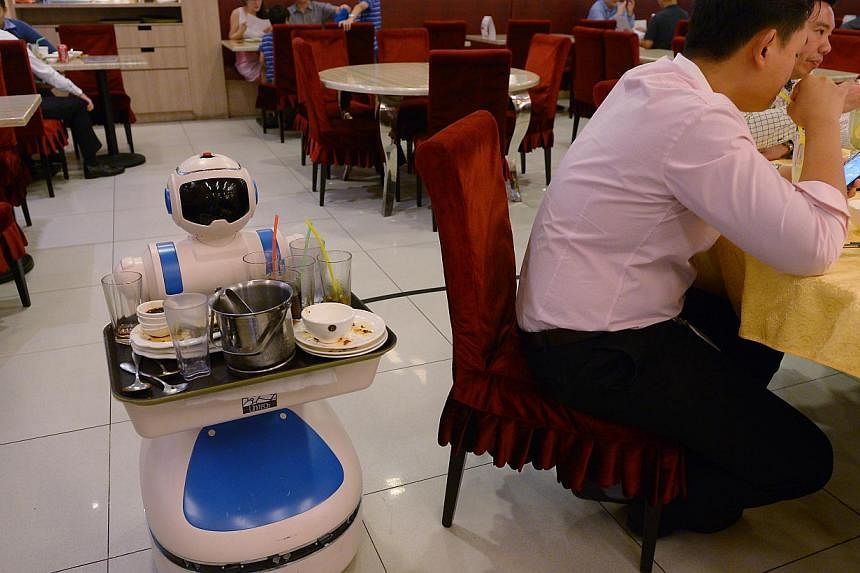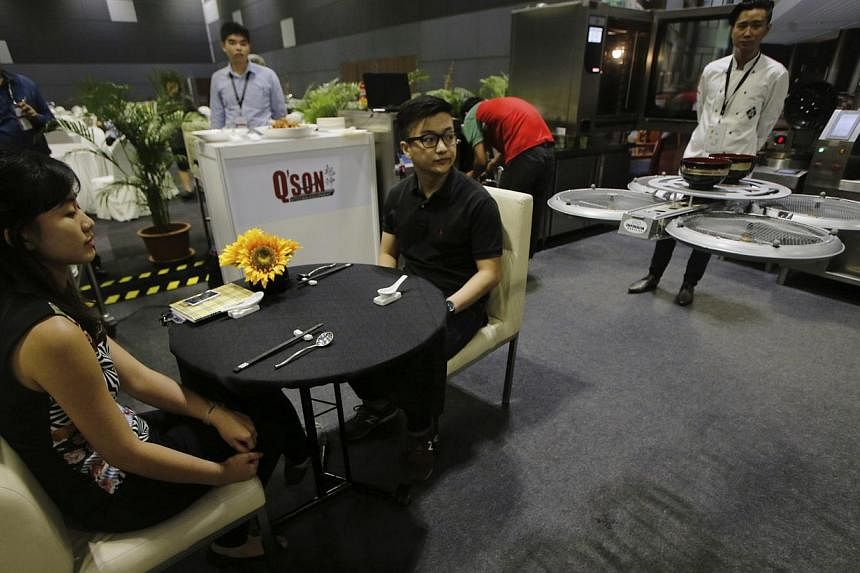A friendly waiter has been the centre of attention at Marina Square's Supreme Tastes Jiang Nan Chun.
Standing at 1.2m tall, the 20kg handy helper does not boast movie-star looks but is just what you would expect to see in a sci-fi flick.
Meet the next big thing in the restaurant scene here - an Autonomous Delivery Robot that clears dishes.
Made of ABS (acrylonitrile butadiene styrene), a type of plastic material, it moves along a magnetic black strip in the restaurant and can collect up to 10kg of dirty dishes from dining tables at a go.
Stand in the robot's way and it will stop and say: "Excuse Me." Wave at it and it responds: "Hi, nice to meet you."
Electrical engineer Jiang Lanzi, 29, is one of many diners at the Chinese restaurant who have been intrigued by the robot.
"It seems safe to me as the robot stopped when I stood in front of it. I guess it is smart enough to know that someone is blocking its way," he says.
Mr Jiang also welcomes the fact that the robot seems to free up its human counterparts so "we got more attention from the waiters".
While it is a novel idea for diners, restaurateurs are seriously looking to harness technology for other front-end services.
Plagued by a manpower crunch, many in the F&B industry have implemented automation in restaurants over the years - think ordering via the iPad and using pre-programmed machines for cooking.
Supreme Tastes Jiang Nan Chun has been deploying its robot without a hitch since June. It is considering buying more robots.
Restaurant manager Joey Zou, 36, says: "Normally, one person takes orders while another clears the dirty plates. I would say that the robot can take the place of half a worker as a waiter still has to take the dishes from the robot to the washing area."
However, the fuss over the robot can be disruptive.
"Sometimes, if the restaurant is very crowded, I have to keep the robot because the children will follow it all over the restaurant," says Ms Zou. "The staff will have to look out for the children instead of the robot."
Made by home-grown engineering company Unitech Mechatronics, the robot costs $50,000. But the restaurant paid $10,000 for it after a subsidy from the Infocomm Development Authority of Singapore.
The automaton can last for about eight hours and its batteries have to be charged in between lunch and dinner services.
Dr James Xia, 48, a director of Unitech Mechatronics, says the company will roll out more robots in three other restaurants early next year.
These automated aides are not limited to ground service, though. Some firms are taking the technology to new heights with drones that can serve food.
Mr Woon Junyang, chief executive of Infinium Robotics, announced last Thursday his tie-up with its first client, lifestyle group Timbre.
The five restaurants under the Timbre Group will feature flying robotic waiters by the end of next year.
Mr Woon, 31, assures that the flying drones are safe.
"They have human face recognition functions and sensors. If something or someone is too near a drone, it will sound an alarm and avoid the obstacle."
The fully automated robots will fly at a minimum height of 2m and descend by the tableside or at a central landing point for waiters to serve customers.
The deal with Timbre is priced at a "low seven-figure sum" and Mr Woon says that each outlet can take four to 12 drones, depending on the restaurant's size and requirements.
Timbre Group's managing director Edward Chia, 30, hopes that the drones will help bring the staff to customer ratio at his outlets to an "optimum level". The current ratio on a busy night is "about 1:40, excluding back-end staff like those at the bar and kitchen", he says.
"Ideally, we would prefer the ratio to be at 1:30."
Timbre also uses iPad menus so customers can browse food items and place orders. There are also real-time online reservation and song dedication systems at all its outlets.
Mr Kelvin Ong, 37, chief executive of the Suki Group of restaurants, has his eye on the Infinium-Serve drones too.
He is looking to launch robotic servers next year at his sushi restaurant chain Nihon Mura Express before rolling it out in other outlets under the group, such as buffet restaurant chain Sakura.
Enterprise agency Spring Singapore is backing Infinium Robotics in its project through the Technology Enterprise Commercialisation Scheme, a competitive grant that supports new start-ups.
Eager to tackle their manpower crunch, more F&B operators are turning to Spring Singapore to help fund related manpower- saving initiatives.
Last year, 470 restaurants were given subsidies in various productivity and service upgrading projects such as wireless ordering.
The number has jumped by almost 45 per cent to 680 restaurants this year, notes Mr Chin Sau Ho, 49, Spring Singapore's director of corporate communications.
However, some F&B operators feel that using robots may compromise the dining experience.
Mr James Quek, 58, chief operating officer of Crystal Jade Culinary Concepts Holding, says: "I would consider ground robots if they help to increase productivity and efficiency. However, drones may not be suitable for use in Chinese restaurants, which require staff interaction with customers."
And while Mr Andrew Tjioe, 55, executive chairman of the TungLok Group and president of the Restaurant Association of Singapore, is concerned about the noise and draft from the flying Infinium-Server, he is keen to support initiatives that can help reduce the reliance on manpower.
Last year, TungLok Group was the first to invest in three Artificial Intelligence Cooking Machines, which are preprogrammed to cook dishes at fastfood-style Chinese restaurant Ruyi in Resorts World Sentosa and Changi Airport Terminal 1.
He says: "After using the cooking machines, our chefs have become dependent on them. They can't live a day without the machines now. I don't know how popular the robot servers will be, but the market is in need of ideas like this."



